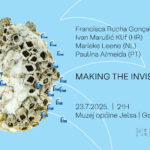Split Mayor and the director of the Croatian National Tourist Board met to discuss further development of the city
In 2017, Split has been breaking records in tourism, generating impressive traffic and revenue. Such progress requires a solid development plan to ensure the city infrastructure remains able to keep up with a constantly growing number of visitors. Split Mayor Andro Krstulović Opara met with Kristijan Staničić, the director of the Croatian National Tourist Board (HTZ), to discuss some of the key issues regarding further tourism development, reports Dalmacija danas on October 18, 2017.
Opara and Staničić agreed there is a need for expanding and reinforcing the quality of the tourist offer, in order to generate positive effects of tourism throughout the year. They also talked about the possibility of relieving the pressure on the infrastructure in the summer season, especially in the larger cities on the coast. The example of Split was used to point to issues in traffic, waste management, and medical care. There is also the problem of income from tourism far surpassing the revenue generated by the local authorities; the city budget does not reflect the economic growth in the tourism sector, so the burden of expenses again falls on citizens.
The issue isn’t exclusively related to Split, as many prominent tourist destinations on the Croatian Adriatic experience the same phenomenon. The biggest city in Dalmatia still remains a good example of the problem: the Port of Split recorded 3.5 million passengers, Split Airport recorded 2 million, and 2.5 million overnight stays were generated in the entire city in 2017. The tourism traffic increased by 243%, but the outstanding results left no trace on the city budget. This is why Mayor Opara asked the HTZ for support, both direct and indirect, regarding the infrastructure development and various cultural and entertainment projects. No destination can grow without the state’s support, so Opara pointed to the need for connecting the airport with the railway in Kaštel Stari. There’s also the problem of insufficient state-provided support for Ultra, a festival that promotes the entire region on the global market and generates an immense number of guests.
“Both the airport and the national shipping company [Jadrolinija] generate substantial income in Split. They should invest a part of the revenue in the city, so the current offer could be solidified and expanded, resulting in further expansion of the tourist season. Simultaneously, the City can come up with new manifestations in order to develop the pre-season and the post-season”, said the mayor, adding they are currently planning to enrich the offer by organising events not only on the waterfront, but at other locations in the city as well.
Director Staničić agreed that Split again proved itself as one of the leaders in Croatian tourism, and that it’s globally known as a destination with recognisable manifestations. He also agreed insisting on the quality of the offer is mandatory if the country wants to further develop sustainable tourism. When it comes to Ultra Europe, he stated the festival changed the profile of visitors and enticed an increase in the number of accommodation facilities, especially privately owned apartments. “Ultra is a large-scale project that everyone should be a part of – from the local authorities and the National Tourist Board to the state. Everyone needs to participate in such projects”, said Staničić.
Considering that one of HTZ’s goals is to position Croatia as an airport destination, Staničić also praised the idea of connecting the airport with the city by train, adding that certain plans for connecting the airport and Split by catamaran lines might also soon be in the works.








